Best Practices for Irrigation Sprinklers vs Drip Systems
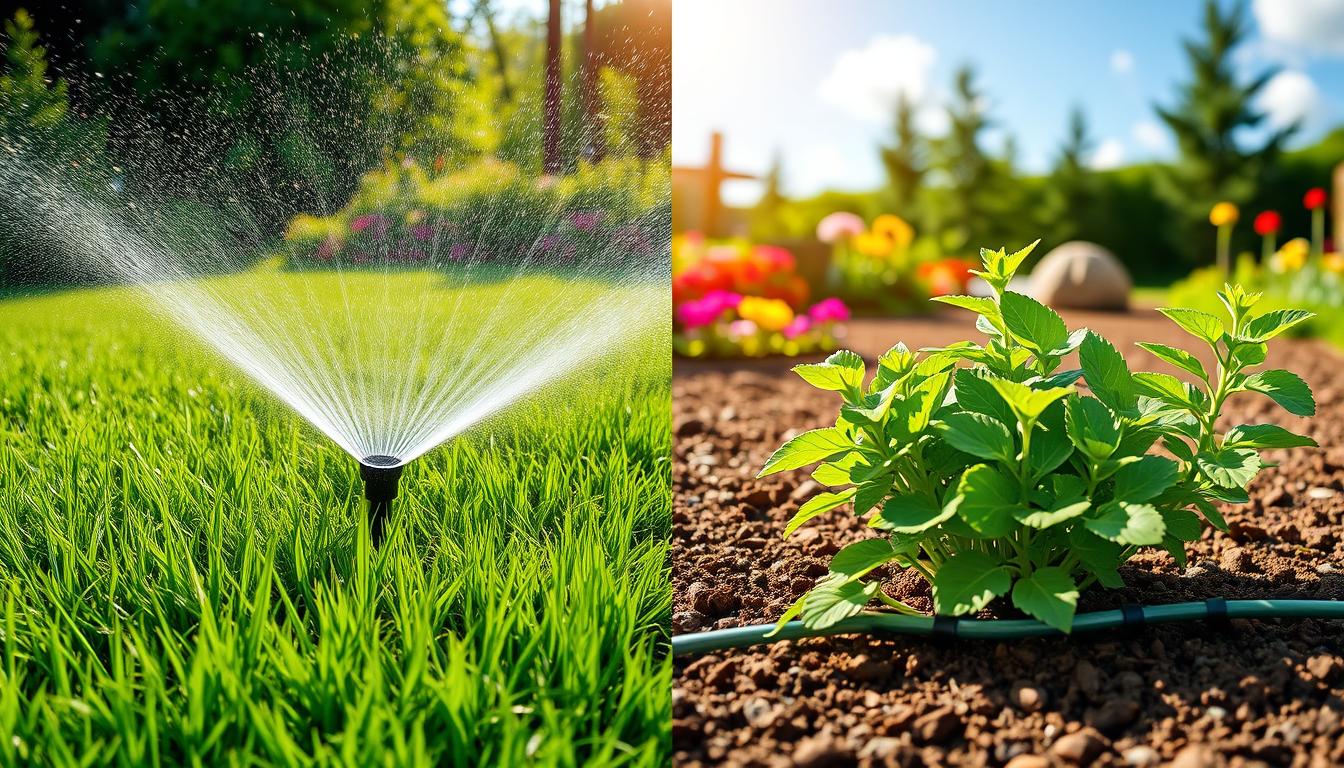
Sprinklers vs drip: which one saves more water for your landscape?
Did you know drip irrigation systems can save up to 50% of water compared to old methods?
This fact shows how much water we can save with new irrigation tech. As a homeowner or landscaper, knowing the pros and cons of drip vs sprinkler systems is key. This guide will help you choose the best for your outdoor space, saving water and keeping it green.
Key Takeaways
- Drip irrigation systems can reduce water usage by 30-50% compared to traditional methods.
- Drip irrigation systems are highly efficient, allowing up to 90% of the applied water to be used by plants.
- Drip systems promote deep root growth and reduce weed and disease issues by delivering water precisely to the plant’s base.
- Sprinkler systems are easy to install and can cover larger areas, but they are less water-efficient and can lead to water waste.
- Incorporating smart technology, such as weather-based controllers and soil moisture sensors, can further optimize water usage for both sprinkler and drip irrigation systems.
Understanding Drip Irrigation Systems
Drip irrigation, also known as micro-irrigation, is a smart way to water plants. It sends water straight to the roots through tubes and emitters. This method cuts down on evaporation and runoff, saving water and helping plants grow better.
Knowing the good and bad of drip irrigation helps homeowners choose the right watering system for their yard.
Advantages of Drip Irrigation Systems
Drip irrigation systems beat traditional sprinklers in many ways. They use up to 90% less water, saving you money on your water bill. They also help plants stay healthy by watering the roots, not just the leaves.
Drip systems are better for gardens, while sprinklers cover large lawns evenly.
This method also reduces weed growth and makes fertilizers work better.
Disadvantages of Drip Irrigation Systems
While drip irrigation has many benefits, it also has some downsides. It can cost more to set up than sprinkler systems. You might also need to do more upkeep to keep it working right.
The tubing and emitters can be a tripping hazard. They might also be hard to mow around in some yards.
To make a drip irrigation system work, you need to think about your watering needs, yard layout, and budget. Knowing the pros and cons helps you choose the best option for your yard.
| Watering Schedule | Recommended Duration |
|---|---|
| Spring and Fall | Two days a week |
| Winter | One day a week or less |
| Summer | Four days a week |
Knowing how often and for how long to water with drip irrigation helps your plants thrive. It also saves water all year round.
“Drip irrigation exceeds 90% efficiency while sprinkler systems are 50 to 70% efficient.” – Sam, lawn specialist
Traditional Sprinkler Systems: An Overview
Traditional sprinkler systems are a favorite for watering lawns. They provide even coverage over big areas. These systems have underground pipes, valves, and sprinkler heads to spread water evenly.
They need less maintenance than other methods. But, they can use more water because of evaporation, wind, and runoff.
Advantages of Traditional Sprinkler Systems
- Even coverage across large areas
- Cost-effective installation compared to some alternative systems
- Relatively low maintenance requirements
- Sprinklers are easier to install, but drip systems are more water-efficient
Disadvantages of Traditional Sprinkler Systems
- Potential for water waste due to evaporation, wind, and runoff
- Possible uneven distribution leading to over or underwatering certain areas
- May not be as water-efficient as some newer irrigation technologies
| Metric | Traditional Sprinklers | Drip Irrigation |
|---|---|---|
| Water Efficiency | 60-80% | 90-95% |
| Maintenance | Low | Moderate |
| Installation Cost | $1,500 – $3,000 | $2,000 – $4,000 |
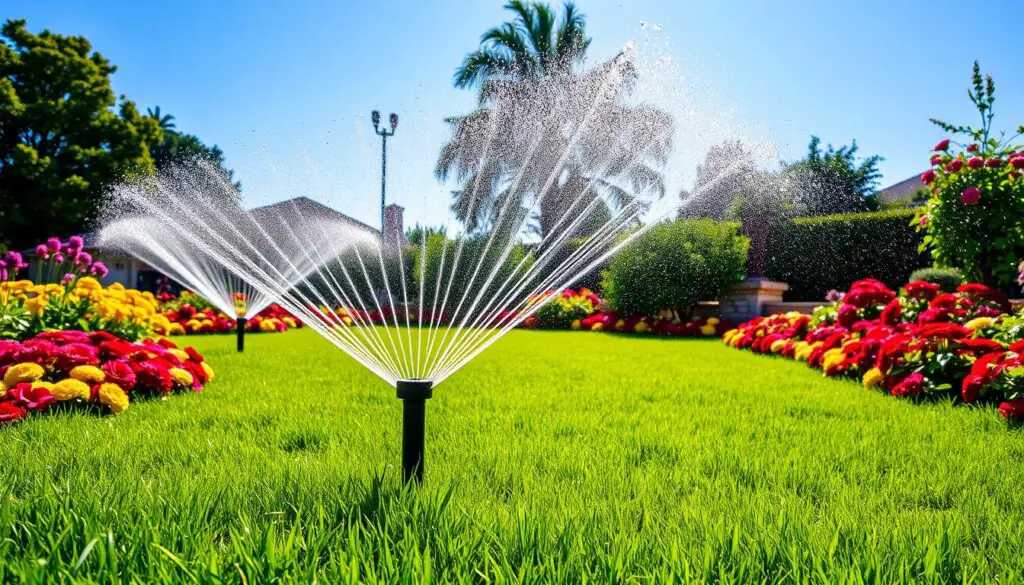
“Up to 50 percent of outdoor watering may be wasted due to evaporation, wind, or runoff from overwatering.” – Sam, Mowers Guide author
Efficiency Considerations: Traditional Sprinklers vs Drip Systems
Sprinklers vs drip is a choice based on landscape size, budget, and water-saving goals.
Irrigation systems need to be efficient. Drip irrigation systems are known for their efficiency. They deliver water right to the roots, cutting down on evaporation and runoff. In fact, they can save up to 70% more water than traditional sprinklers, as industry data shows.
The United Nations Food and Agricultural Organization says drip irrigation uses up to 90% of water. Traditional sprinklers use 50-70%. This big difference means a lot of water saved and lower bills over time.
| Metric | Drip Irrigation | Traditional Sprinklers |
|---|---|---|
| Water Use Efficiency | Up to 90% | 50-70% |
| Water Savings | Up to 70% | N/A |
| Utility Cost Savings | Significant | Moderate |
Traditional sprinklers can get better with smart tech like weather controllers and sensors. But drip irrigation is still the best for saving water. Drip systems send water straight to the roots, reducing evaporation and runoff. This is a big problem with sprinklers, which can lose a lot of water in windy or sunny weather.
In short, drip irrigation’s water efficiency and ability to cut water consumption and utility costs make it a top choice. It’s great for homeowners and landscapers who want to save water and money.
Installation and Maintenance Costs
Irrigation systems have different costs for installation and upkeep. Drip irrigation systems cost more upfront but save water in the long run. Traditional sprinklers are cheaper to install, but they might need more maintenance.
The cost to install sprinklers varies, with an average of $2,700. Prices range from $450 to $4,700, depending on the system. Drip irrigation costs $1,800 to $2,500 per acre, while sprinklers can cost more or less.
Maintenance costs also vary. Sprinklers need less upkeep than drip systems, which may need cleaning and part replacements. Sprinkler repairs cost between $130 to $360. Lawn care services like mowing can cost $35 to $480 per visit.
It’s important to choose a landscaping company with insurance. This protects both the company and the homeowner from unexpected costs or damages.
| Item | Average Cost |
|---|---|
| Sprinkler System Installation | $2,700 (range: $450 – $4,700) |
| Above-Ground Irrigation Systems | $1,800 – $2,000 per acre |
| Underground Irrigation Systems | $6,400 – $12,000 per acre |
| Drip Irrigation Systems | $1,800 – $2,500 per acre |
| Sprinkler Repair | $130 – $360 |
| Professional Lawn Care Services | $35 – $480 per service |
Choosing between drip irrigation and sprinklers depends on your landscape, budget, and water-saving goals. Knowing the costs helps you make a choice that fits your needs.
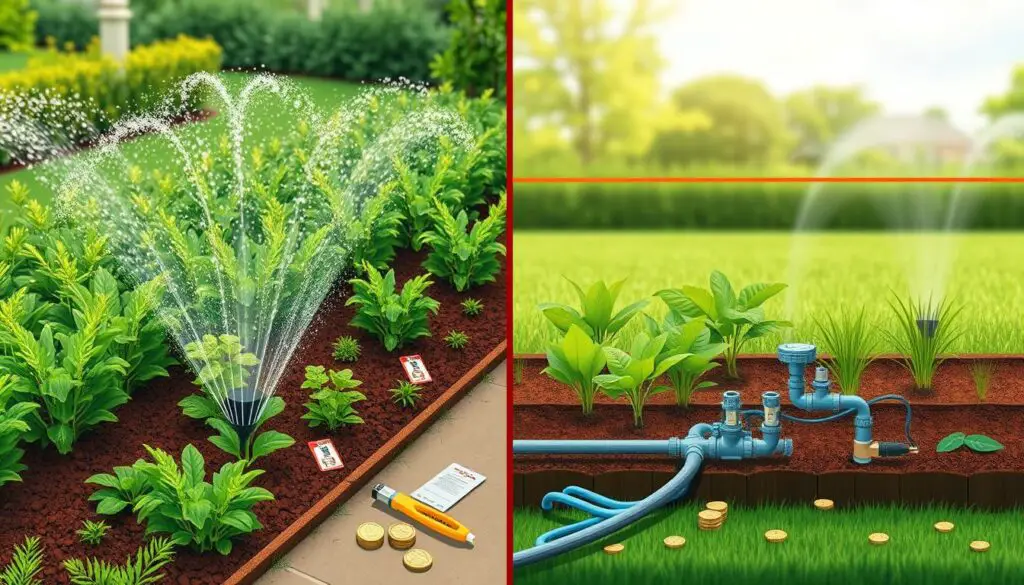
Adapting to Different Landscape Types
Choosing between drip systems and traditional sprinklers depends on your landscape’s needs. Drip irrigation is great for gardens and areas with lots of plants. It helps plants grow better and keeps weeds down. Traditional sprinklers work best for big lawns and fields, covering a lot of grass evenly.
It’s important to know what your landscape needs. Drip irrigation is perfect for places with lots of plants. It waters the roots directly, saving water and helping plants grow well.
Traditional sprinklers are better for big lawns. They make sure water covers the whole area evenly.
| Landscape Type | Recommended Irrigation System | Key Considerations |
|---|---|---|
| Gardens and Flower Beds | Drip Irrigation | Targeted watering, high plant density, reduced weed growth |
| Large Lawns and Athletic Fields | Traditional Sprinklers | Even water coverage, maintaining uniform lawn coverage |
| Mixed Landscapes | Combination of Drip and Sprinklers | Tailoring irrigation to specific zones and plant types |
Think about your landscape types carefully. This helps you pick the right irrigation system. It ensures your plants grow well and you use water wisely.
“Adapting your irrigation system to the specific needs of your landscape is the key to maintaining a thriving, sustainable outdoor environment.”
Environmental Impact and Water Conservation
Water conservation is more important than ever. Choosing the right irrigation system is key for a green, sustainable lawn. Drip irrigation is the most water-efficient, saving up to 90% of water. Traditional sprinklers can also be improved with smart technology to cut down on water waste.
Smart Irrigation Technology Integration
Adding smart tech to irrigation systems boosts water saving. Weather-based controllers adjust watering based on weather. Soil moisture and rain sensors prevent overwatering, saving a lot of water.
“Proper irrigation management can reduce outdoor water usage by 20-50%.” – Sam, lawn specialist
Smart irrigation technology helps homeowners save water and money. It’s good for the environment and your wallet. It’s a step towards a greener future.
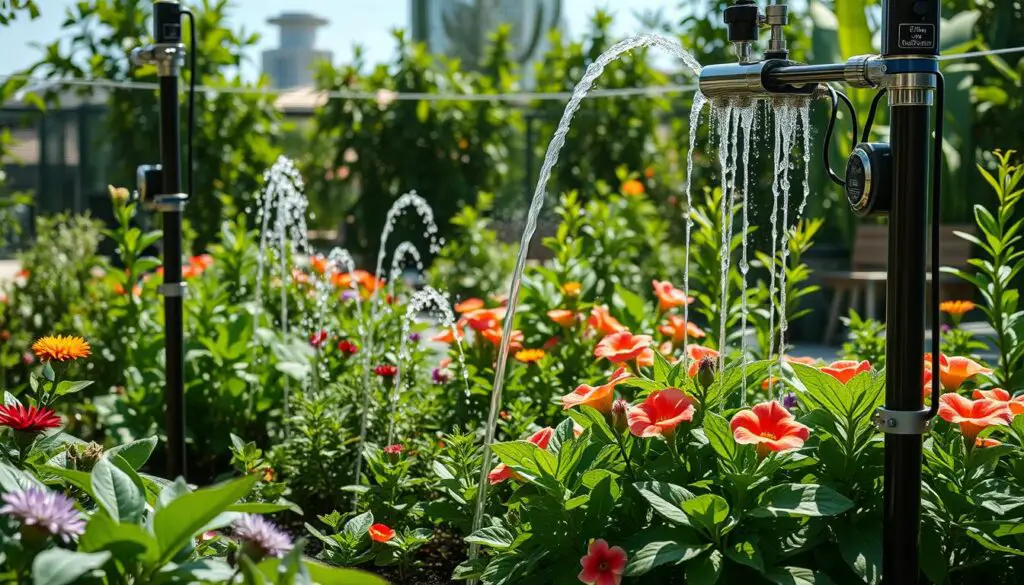
Using drip irrigation or traditional sprinklers with smart tech is smart. It helps save water and keeps your lawn looking great. Homeowners can enjoy a beautiful lawn while protecting our water resources.
Lawn Irrigation Tips
To keep your lawn lush and green, you need to water it right. Whether you use drip irrigation or sprinklers, water wisely to save water and help your lawn grow. Follow these tips to keep your lawn looking great and use less water.
- Change your watering schedule with the seasons. Your lawn might need more water in hot months and less in cooler ones.
- Check your sprinkler system often for clogs or leaks. Fixing these can save water and prevent waste.
- Think about adding drought-resistant plants or xeriscaping to use less water.
- Use smart irrigation tech like weather controllers or soil sensors to water only when needed.
- Water your lawn in the early morning or evening to reduce evaporation and use water better.
By using these lawn irrigation tips, you can keep your lawn healthy and green while saving water. Remember, taking care of your sprinklers and checking soil moisture are key to a lush, drought-tolerant lawn.
| Benefit | Impact |
|---|---|
| Investing in an automatic sprinkler system | Can save money and water the lawn evenly and efficiently. |
| Pressure regulating spray heads | Can save up to 106,000 gallons of water per year and meet state guidelines in places like California, Washington, Colorado, and others. |
| The cycle and soak method of irrigation | Can reduce runoff by watering in short, intermittent periods instead of one long cycle. |
| Using a smart controller connected to the Internet | Can stop watering if rain is forecasted, providing precise irrigation based on local weather. |
“Watering the lawn in the early morning or evening can help minimize evaporation and save water compared to watering during the hottest part of the day.”
Incorporating Smart Technology for Efficient Watering
The use of smart irrigation technology has changed how we care for our lawns. Drip irrigation and sprinkler systems can now be improved with weather-based controllers and soil moisture sensors. These tools adjust watering based on soil moisture, weather, and plant needs. They let you remote monitor and adjust, saving water by adapting to changes.
Weather-Based Controllers and Sensors
Weather-based controllers cut down on water waste by adjusting schedules for rain. The US Environmental Protection Agency says 50% of outdoor water is wasted. Smart irrigation technology uses weather and soil data to save water, making a big difference.
“New irrigation controllers can help reduce water wastage by using real-time weather data, soil moisture sensors, leak detectors, and flow meters.” – Laura, lawn health enthuasiast
Soil moisture sensors can save up to 72% on irrigation and 34% during droughts. These systems work with smart home tech for better water management.
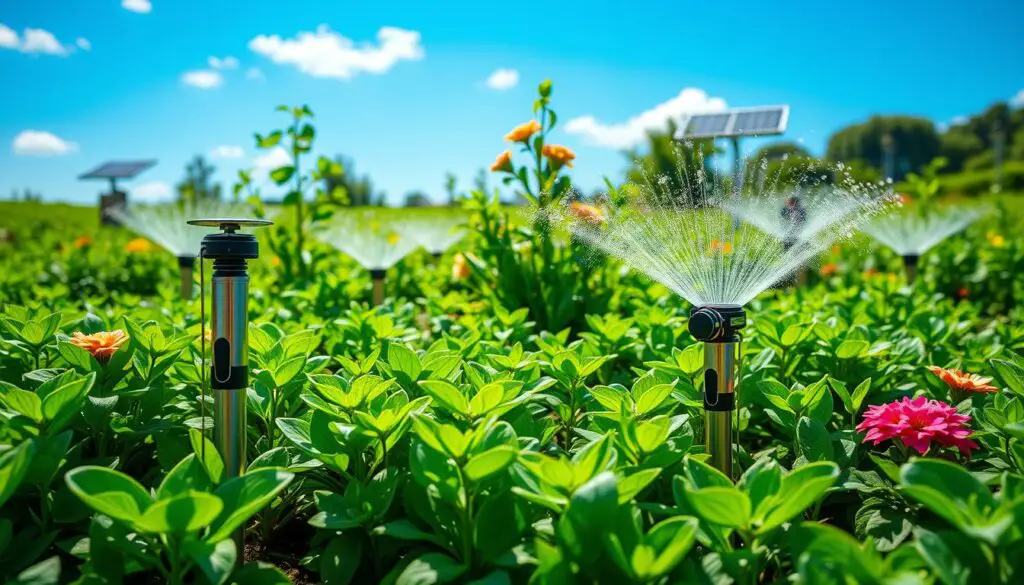
Using smart irrigation technology makes lawns more sustainable and green. It lets homeowners tailor care with data, saving water and keeping lawns healthy and beautiful.
Choosing the Right Irrigation System for Your Landscape
Choosing the right irrigation system is all about balance. You need to think about your property’s size and layout, your plants’ watering needs, and your desire to save water. Drip irrigation systems are great for gardens and areas with lots of plants. On the other hand, sprinkler systems are better for covering large lawns evenly.
For small yards or gardens, simple systems like manual sprinklers or drip irrigation might be enough.
But for bigger properties or commercial landscapes, you might need a more complex system like an underground sprinkler with multiple zones.
Remember to consider water pressure, climate, and natural water sources when picking your irrigation solution.
The best irrigation system is one that fits your landscape’s needs perfectly. By looking at your plants, their water needs, and your property’s size, you can pick a system that waters efficiently. This way, you can grow healthy plants while saving water. With the right system, you can have a beautiful, sustainable landscape that shows your commitment to water conservation.
FAQ
What are the main differences between drip irrigation and traditional sprinkler systems?
What are the advantages of drip irrigation systems?
What are the advantages of traditional sprinkler systems?
How do the installation and maintenance costs compare between drip irrigation and traditional sprinklers?
How can I determine the best irrigation system for my landscape?
How can I improve the water efficiency of my irrigation system?
What are some tips for maintaining a healthy, water-efficient lawn?
Source Links
- https://www.the71percent.org/lawn-care-practices-that-promote-water-conservation/
- https://www.aquarionwater.com/conservation/lawn-and-garden-irrigation-tips
- https://theturfgrassgroup.com/lawn-care-tips/8-simple-ways-to-conserve-water-on-your-lawn/
- https://www.rainbird.com/homeowners/blog/6-tips-to-water-your-lawn-responsibly
- https://www.lawnstarter.com/lawn-irrigation
- https://www.groundsguys.com/blog/lawn-watering-tips/
- https://extension.okstate.edu/fact-sheets/smart-irrigation-technology-controllers-and-sensors.html
- https://www.atidymind.co.uk/smart-landscaping-integrating-technology-for-a-healthier-lawn/
- https://cltwaterblog.org/2023/04/outdoor-water-conservation-smart-irrigation-other-useful-tips/
- https://www.conservairrigation.com/richmond/about-us/blog/2024/april/choosing-the-right-irrigation-system-for-your-la/
- https://hittlelandscape.com/blog/irrigation-systems-101-choosing-the-right-system-for-your-landscape/

